Enhancing Disparity in Water Distribution within Irrigation Systems Aimed at Improving the Conflict Domain under Alternative Perspectives: A Reliable Multi-Objective Framework
Abstract
:1. Introduction
2. Methods
2.1. Assessment of Conflict Domain within the Irrigation System
2.2. An Optimal Multi-Objective Disparity Framework
2.3. Case Study and Data Collection
3. Results and Analysis
3.1. Investigating the Reliability Index with Regard to Available Water Resources and the Overall Distribution of Water Among Multi-Crops
3.2. Optimal Trade-Off for Irrigation Disparity Under Various Weight Scenarios
3.3. Enhancing Crop Water Management Aimed at Improving Conflict Domain
3.4. Analysis of Conflict Domain with Regard to Water Distribution
4. Discussion
5. Conclusions
Funding
Institutional Review Board Statement
Data Availability Statement
Conflicts of Interest
References
- Wei, X.; Allen, N.J.; Liu, Y. Disparity in organizational research: How should we measure it? Behav. Res. Methods 2016, 48, 72–90. [Google Scholar] [CrossRef]
- Statman-Weil, Z.; Nanus, L.; Wilkinson, N. Disparities in community water system compliance with the Safe Drinking Water Act. Appl. Geogr. 2020, 121, 102264. [Google Scholar] [CrossRef]
- Mahdi, M.; Xueqian, S.; Yuan, H.; Amani-Beni, M. Enhancing Equitable Water Distribution in Agriculture: A Novel Optimal Framework for Irrigation Equity Index Improvement Under Diverse Adaptation Strategies. Water Resour. Manag. 2024, 38, 2669–2685. [Google Scholar] [CrossRef]
- Wudil, A.H.; Ali, A.; Usman, M.; Radulescu, M.; Sass, R.; Prus, P.; Musa, S. Effects of inequality of access to irrigation and water productivity on paddy yield in Nigeria. Agronomy 2023, 13, 2195. [Google Scholar] [CrossRef]
- Yin, L.; Tao, F.; Chen, Y.; Wang, Y. Reducing agriculture irrigation water consumption through reshaping cropping systems across China. Agric. For. Meteorol. 2022, 312, 108707. [Google Scholar] [CrossRef]
- Hassan, W.; Manzoor, T.; Muhammad, A. Improving equity in demand-driven irrigation systems through a rights-preserving water allocation mechanism. Agric. Water Manag. 2023, 287, 108443. [Google Scholar] [CrossRef]
- Yuan, H.; Mahdi, M.; Xueqian, S.; Galoie, M. A novel robust evaluation approach to improve systematic behavior of failure safety in water supply system under various ellipsoid uncertainties. Sci. Rep. 2024, 14, 8746. [Google Scholar] [CrossRef] [PubMed]
- Davis, K.F.; Rulli, M.C.; Seveso, A.; D’Odorico, P. Increased food production and reduced water use through optimized crop distribution. Nat. Geosci. 2017, 10, 919–924. [Google Scholar] [CrossRef]
- Yin, X.; Feng, Q.; Zheng, X.; Wu, X.; Zhu, M.; Sun, F.; Li, Y. Assessing the impacts of irrigated agriculture on hydrological regimes in an oasis-desert system. J. Hydrol. 2021, 594, 125976. [Google Scholar] [CrossRef]
- Velpuri, N.M.; Senay, G.B. Partitioning evapotranspiration into green and blue water sources in the conterminous United States. Sci. Rep. 2017, 7, 6191. [Google Scholar] [CrossRef]
- He, Y.; Mahdi, M.; Huang, P.; Xie, G.; Galoie, M.; Shafi, M. Investigation of climate change adaptation impacts on optimization of water allocation using a coupled SWAT-bi level programming model. Wetlands 2021, 41, 36. [Google Scholar] [CrossRef]
- Li, M.; Cao, X.; Liu, D.; Fu, Q.; Li, T.; Shang, R. Sustainable management of agricultural water and land resources under changing climate and socio-economic conditions: A multi-dimensional optimization approach. Agric. Water Manag. 2022, 259, 107235. [Google Scholar] [CrossRef]
- Siebert, S.; Döll, P. Quantifying blue and green virtual water contents in global crop production as well as potential production losses without irrigation. J. Hydrol. 2010, 384, 198–217. [Google Scholar] [CrossRef]
- Huang, X.; Fang, H.; Wu, M.; Cao, X. Assessment of the regional agricultural water-land Nexus in China: A green-blue water perspective. Sci. Total Environ. 2022, 804, 150192. [Google Scholar] [CrossRef]
- Hashemy Shahdany, S.M.; Maestre, J.M.; Van Overloop, P.J. Equitable water distribution in main irrigation canals with constrained water supply. Water Resour. Manag. 2015, 29, 3315–3328. [Google Scholar] [CrossRef]
- Li, M.; Xu, Y.; Fu, Q.; Singh, V.P.; Liu, D.; Li, T. Efficient irrigation water allocation and its impact on agricultural sustainability and water scarcity under uncertainty. J. Hydrol. 2020, 586, 124888. [Google Scholar] [CrossRef]
- Ren, C.; Li, Z.; Zhang, H. Integrated multi-objective stochastic fuzzy programming and AHP method for agricultural water and land optimization allocation under multiple uncertainties. J. Clean. Prod. 2019, 210, 12–24. [Google Scholar] [CrossRef]
- Xu, Z.; Yao, L.; Zhou, X.; Moudi, M.; Zhang, L. Optimal irrigation for sustainable development considering water rights transaction: A Stackelberg-Nash-Cournot equilibrium model. J. Hydrol. 2019, 575, 628–637. [Google Scholar] [CrossRef]
- Tong, F.; Guo, P. Simulation and optimization for crop water allocation based on crop water production functions and climate factor under uncertainty. Appl. Math. Model. 2013, 37, 7708–7716. [Google Scholar] [CrossRef]
- Shuai, Y.; He, X.; Yao, L. Robust optimization with equity and efficiency framework for basin-wide water resources planning. J. Environ. Manag. 2022, 321, 115834. [Google Scholar] [CrossRef]
- Karimian, S.; Chamani, A.; Shams, M. Evaluation of heavy metal pollution in the Zayandeh-Rud River as the only permanent river in the central plateau of Iran. Environ. Monit. Assess. 2020, 192, 316. [Google Scholar] [CrossRef] [PubMed]
- Rahimi, M.; Ghorbani, M.; Ahmadaali, K. Exploring the influence of regime shifts on ecosystem services in Iran’s Zayandeh-Rud river basin. Int. J. River Basin Manag. 2024, 6, 1–12. [Google Scholar] [CrossRef]
- Eslamian, S.; Safavi, H.R.; Gohari, A.; Sajjadi, M.; Raghibi, V.; Zareian, M.J. Climate change impacts on some hydrological variables in the Zayandeh-Rud River Basin, Iran. Reviving the Dying Giant: Integrated Water Resource Management in the Zayandeh Rud. Catchment. Iran 2017, 201–217. [Google Scholar]
- Sharifi, A.; Mirchi, A.; Pirmoradian, R.; Mirabbasi, R.; Tourian, M.J.; Haghighi, A.T.; Madani, K. Battling water limits to growth: Lessons from water trends in the central plateau of Iran. Environ. Manag. 2021, 68, 53–64. [Google Scholar] [CrossRef] [PubMed]
- Tavazohi, E.; Ahmadi, M. Assessment of drought in the Zayandehroud basin during 2000–2015 using NDDI and SPI indices. Fresenius Environ. Bull. 2018, 27, 2332–2340. [Google Scholar]
- Moudi, M.; Galoie, M.; He, Y.; Hong, X.; Shafi, M.; Motamedi, A. SWAT based Bi-objective framework for improving the degree of consumer satisfaction in urban water allocation system under streamflow uncertainty. J. Hydro-Environ. Res. 2023, 47, 15–25. [Google Scholar] [CrossRef]
- Sarvari, H.; Rakhshanifar, M.; Tamošaitienė, J.; Chan, D.W.; Beer, M. A risk based approach to evaluating the impacts of Zayanderood drought on sustainable development indicators of riverside urban in Isfahan-Iran. Sustainability 2019, 11, 6797. [Google Scholar] [CrossRef]
- Tokos, H.; Pintarič, Z.N.; Yang, Y. Bi-objective optimization of a water network via benchmarking. J. Clean. Prod. 2013, 39, 168–179. [Google Scholar] [CrossRef]
- Moudi, M.; Galoie, M.; Yuan, H.; Motamedi, A.; Huang, P.; Shafi, M. Dynamic multi-objective programming model for improving consumer satisfaction within water supply system under uncertain environment. J. Environ. Manag. 2021, 293, 112897. [Google Scholar] [CrossRef]
- Xu, J.; Hou, S.; Yao, L.; Li, C. Integrated waste load allocation for river water pollution control under uncertainty: A case study of Tuojiang River, China. Environ. Sci. Pollut. Res. 2017, 24, 17741–17759. [Google Scholar] [CrossRef]
- Zolfagharipoor, M.A.; Ahmadi, A.; Nikouei, A. Market-based groundwater resources allocation mechanism: An inter-sectoral water exchanges programming analysis. Water Resour. Econ. 2022, 37, 100193. [Google Scholar] [CrossRef]
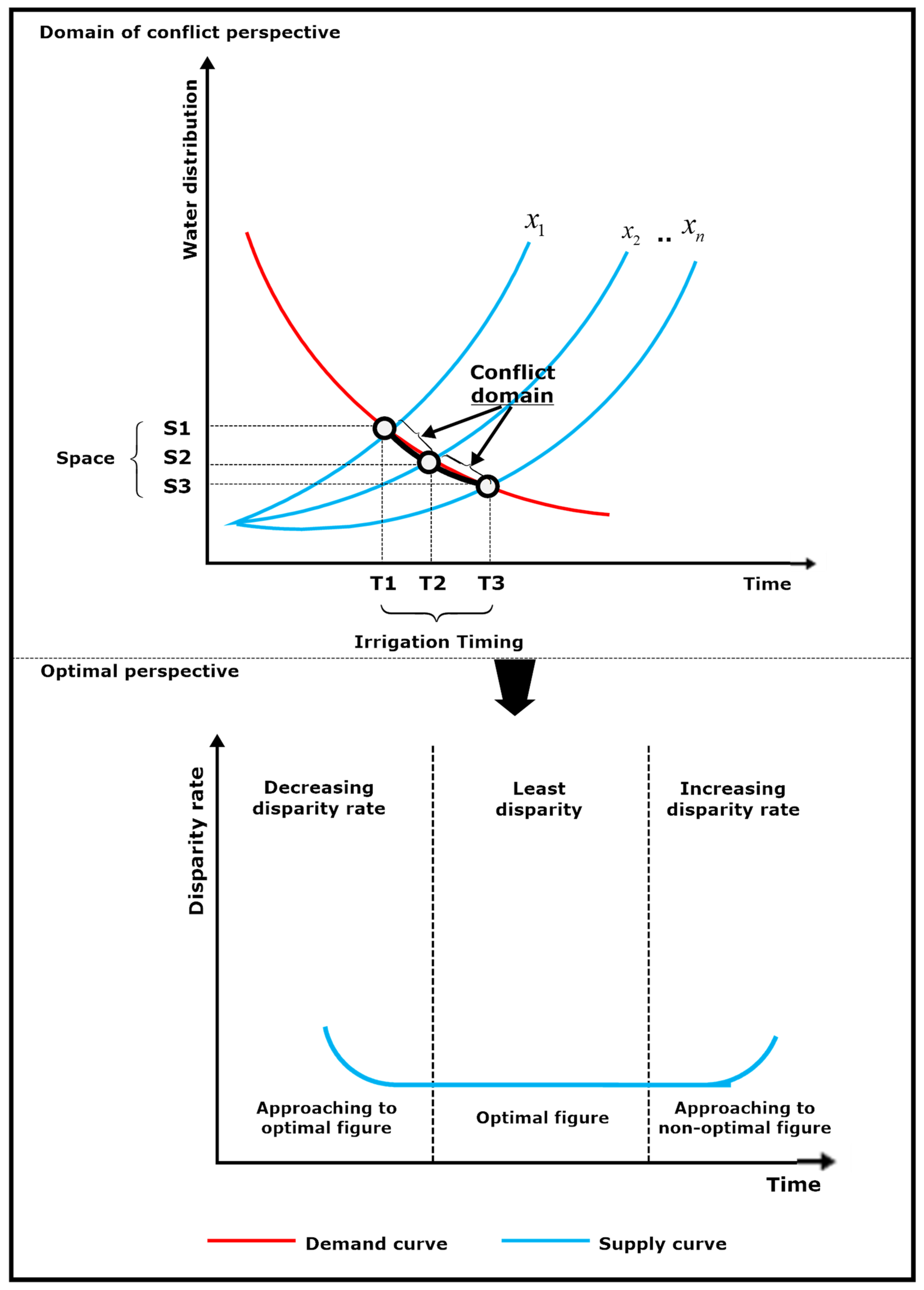
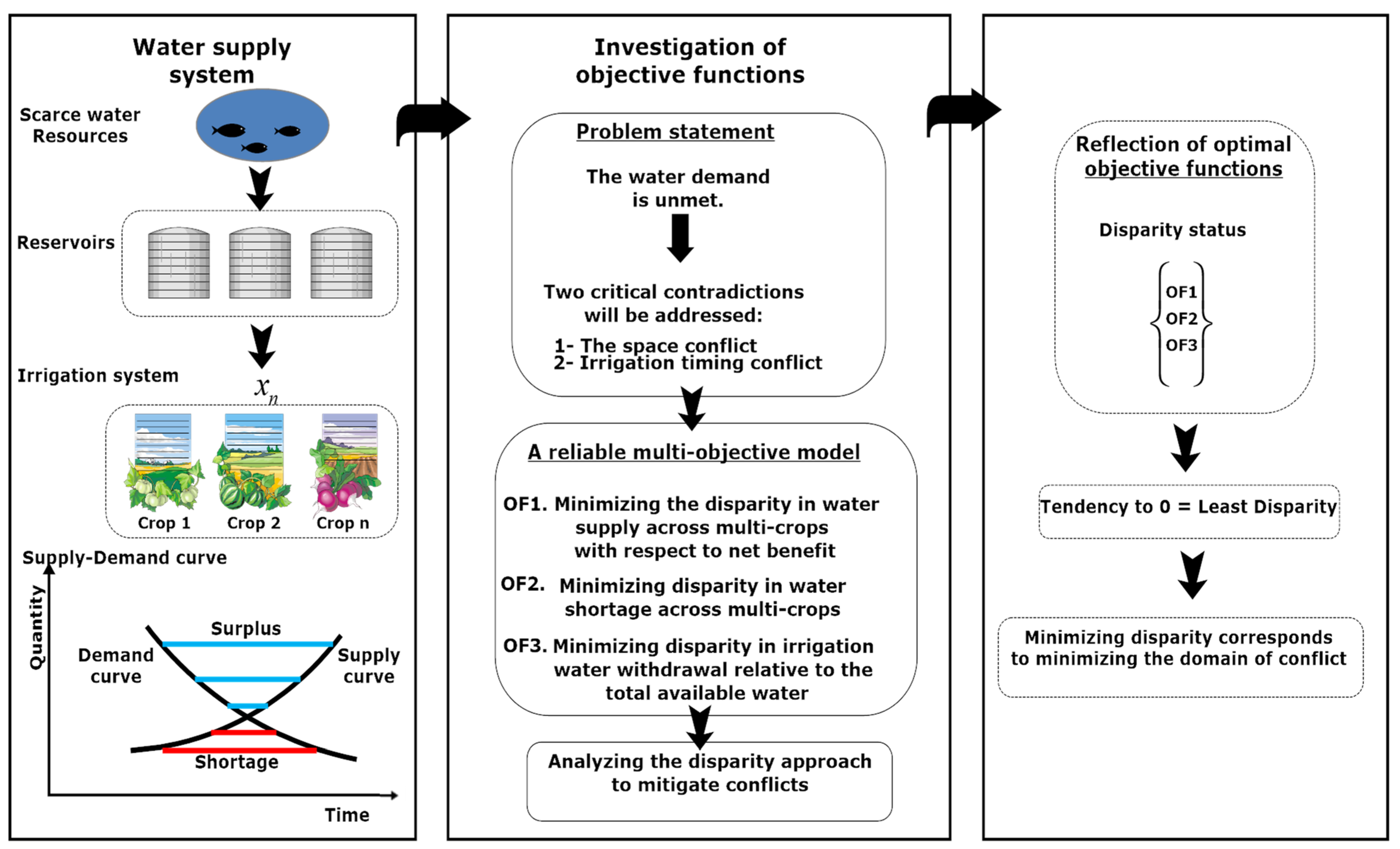
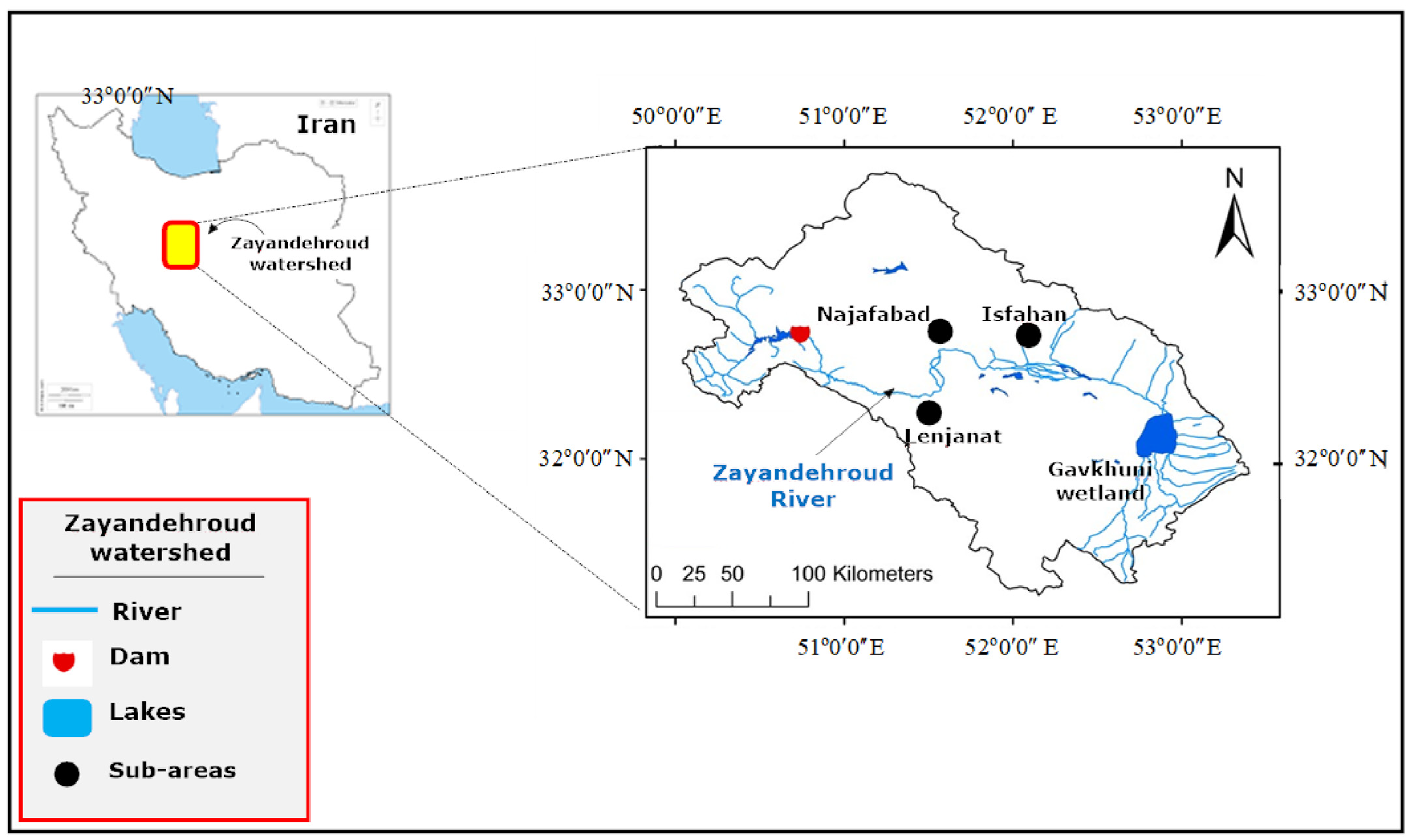
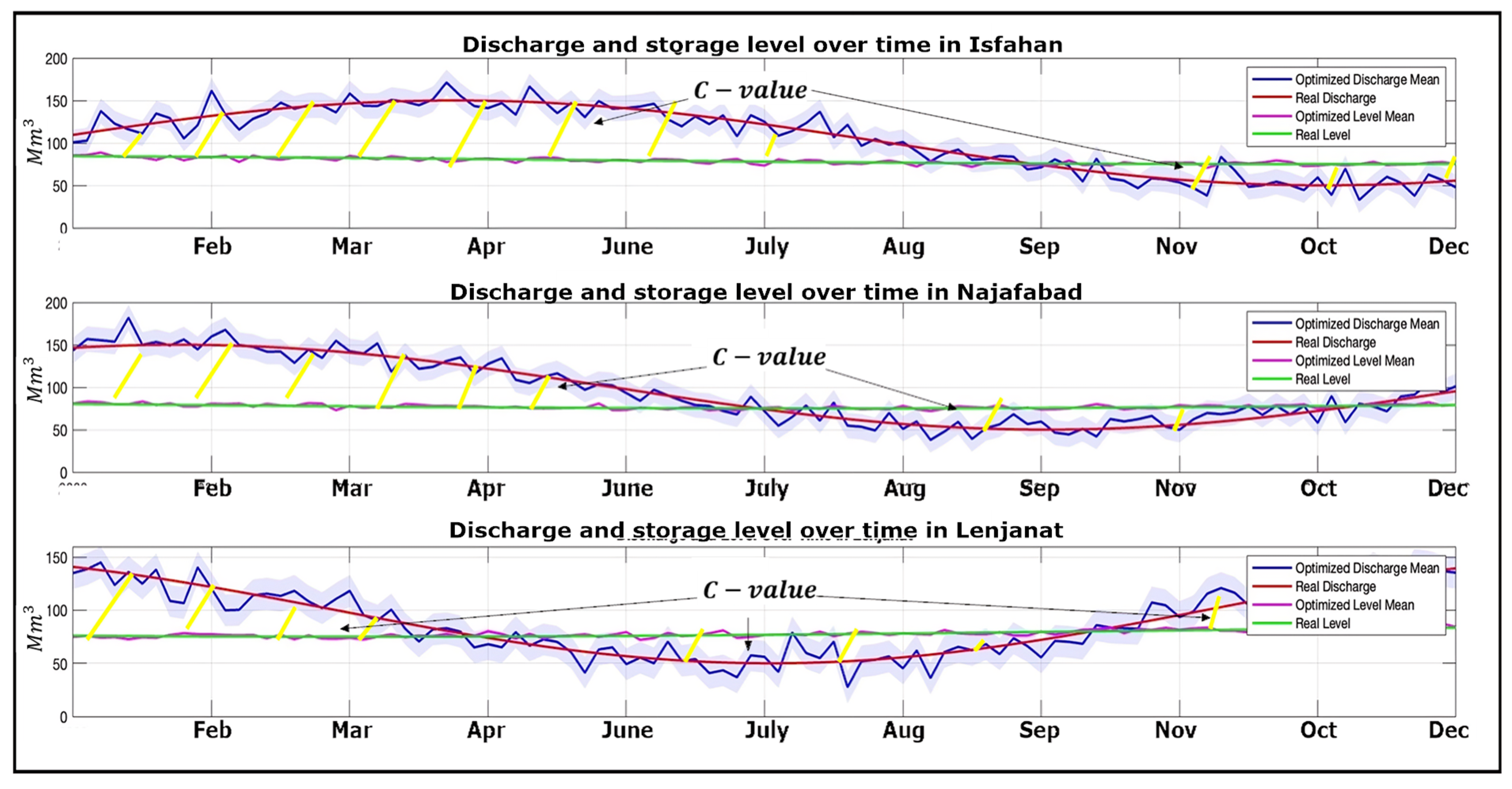
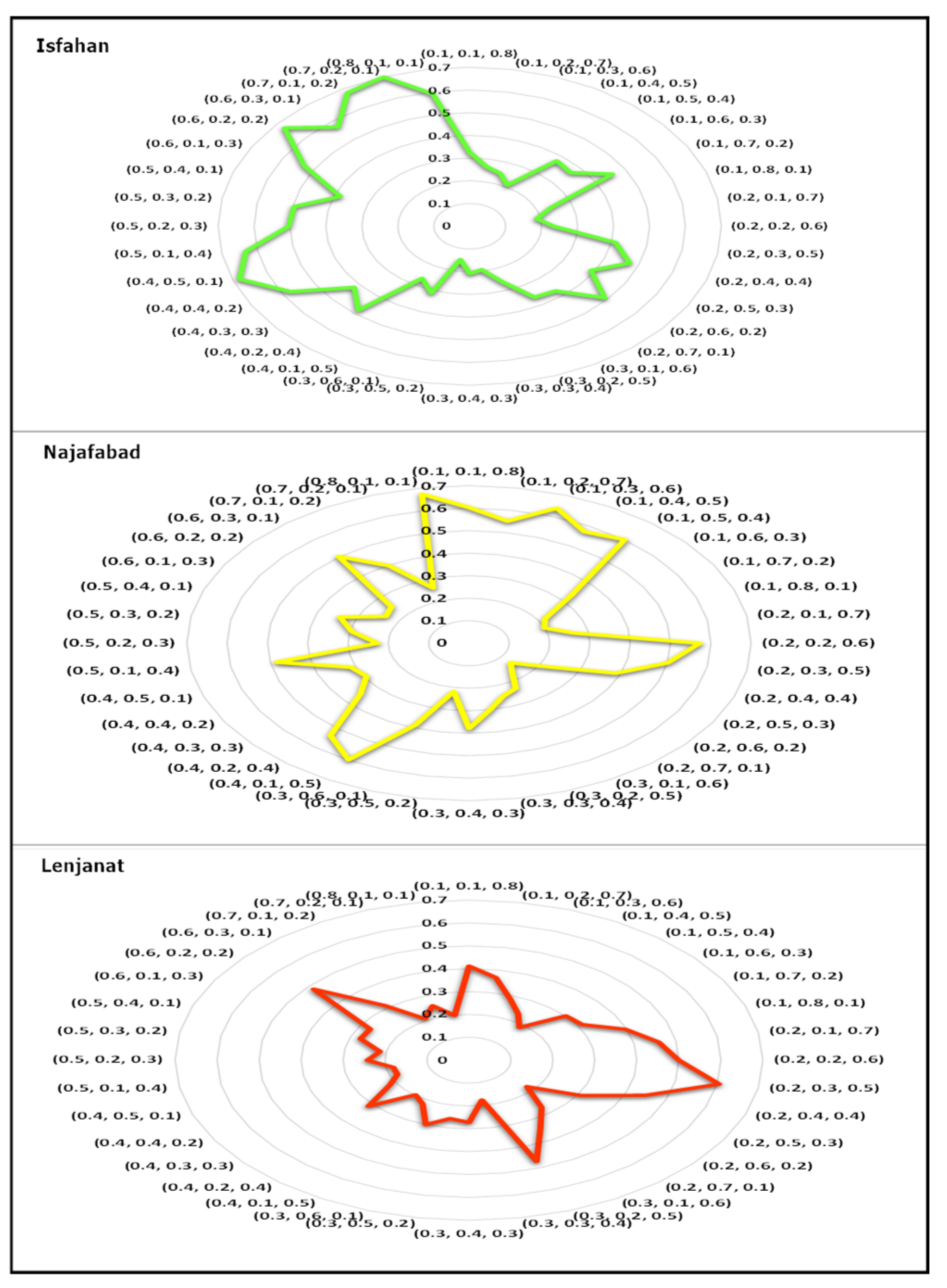
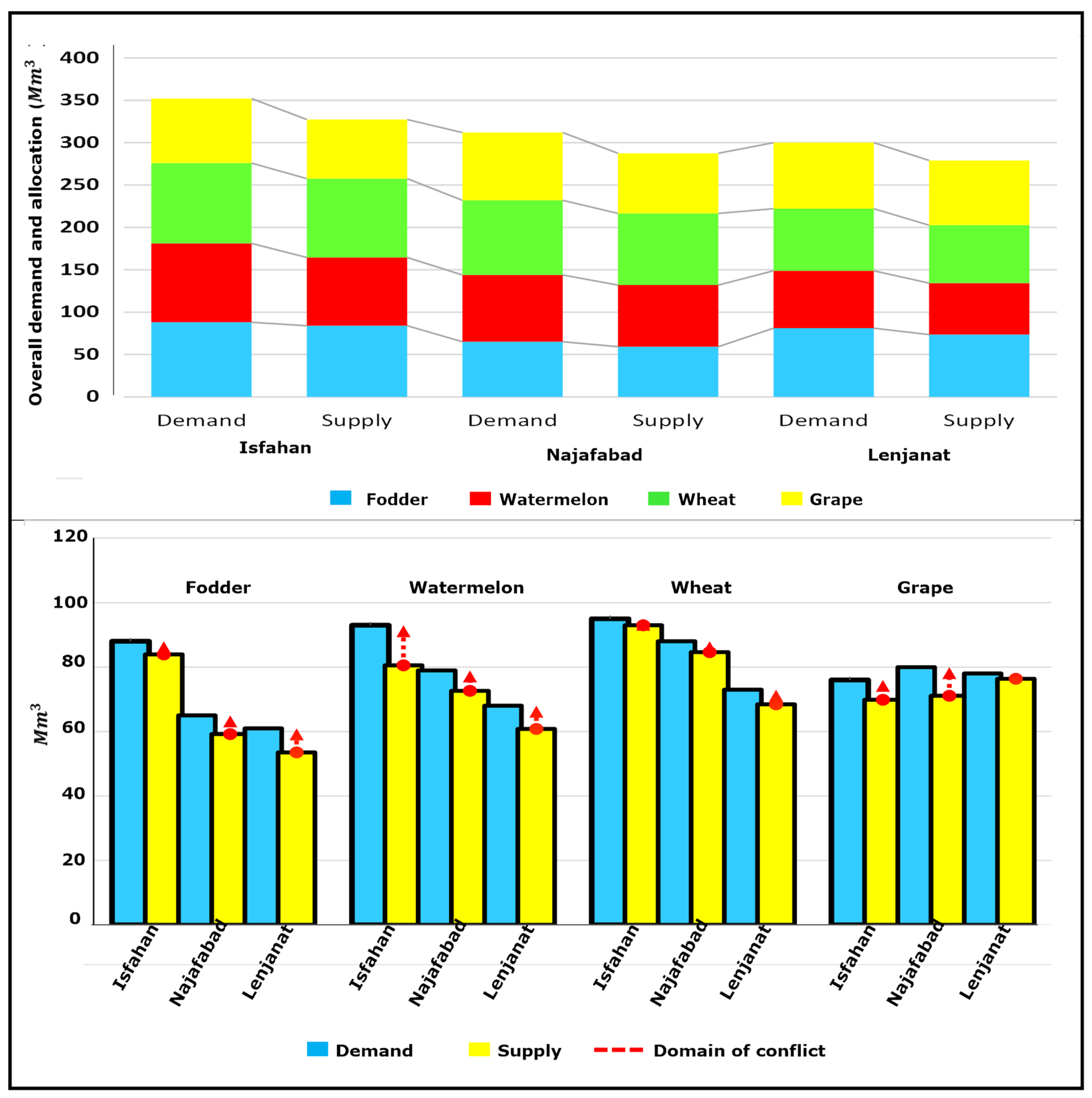

| Isfahan | Najafabad | Lenjanat | |||||||
|---|---|---|---|---|---|---|---|---|---|
| Crop Area | Water Requirement | Precipitation | Crop Area | Water Requirement | Precipitation | Crop Area | Water Requirement | Precipitation | |
| Fodder | 117 | 88 | 2.64 | 102 | 65 | 2.44 | 134 | 81 | 2.27 |
| Watermelon | 169 | 93 | 3.21 | 121 | 79 | 2.89 | 83 | 68 | 1.59 |
| Wheat | 164 | 95 | 1.75 | 146 | 88 | 3.37 | 120 | 73 | 2.02 |
| Grape | 123 | 76 | 2.37 | 98 | 80 | 1.84 | 102 | 78 | 2.62 |
| Crops | Grain | Fodder | Wheat | Grape |
|---|---|---|---|---|
| a | −0.0168 | −0.0299 | −0.0698 | −0.0373 |
| b | 17.37 | 27.687 | 49.314 | 53.180 |
| c | −694 | −11,476 | −10,461 | −7823 |
| Price (IRR/Kg) | 4500 | 1500 | 9500 | 6500 |
| Fodder | Watermelon | Wheat | Grape | |||||
|---|---|---|---|---|---|---|---|---|
| Isfahan | 0.559 | 0.490 | 0.478 | |||||
| ( | 73.46 | 83.05 | 83.76 | 62.50 | ||||
| EBs ( | 13.162 | 15.947 | 16.008 | 10.473 | ||||
| 3284 | 5539 | 4612 | 4680 | |||||
| Najafabad | 0.582 | 0.441 | 0.403 | |||||
| ( | 59.24 | 72.99 | 79.68 | 71.09 | ||||
| EBs ( | 10.562 | 9.482 | 12.397 | 9.132 | ||||
| 2486 | 3856 | 3071 | 3984 | |||||
| Lenjanat | 0.396 | 0.421 | 0.430 | |||||
| ( | 71.47 | 64.02 | 65.25 | 67.96 | ||||
| EBs ( | 15.730 | 7.841 | 10.956 | 9.603 | ||||
| 4081 | 2689 | 2860 | 4146 |
| Reduction in Water Requirements | Fodder | Watermelon | Wheat | Grape | ||||
|---|---|---|---|---|---|---|---|---|
| −5% | −5% | −5% | −5% | −5% | −5% | −5% | ||
| −10% | −10% | −10% | −10% | −10% | −10% | −10% | ||
| Isfahan | 0.512 | 0.467 | 0.435 | |||||
| 0.473 | 0.420 | 0.391 | ||||||
| () | 71.62 | 82.84 | 80.14 | 60.62 | ||||
| 68.26 | 79.02 | 78.39 | 59.87 | |||||
| Harvest crops | 3071 | 5408 | 4569 | 4496 | ||||
| 2897 | 5262 | 4337 | 4248 | |||||
| Najafabad | 0.551 | 0.418 | 0.403 | |||||
| 0.528 | 0.392 | 0.380 | ||||||
| (M) | 58.66 | 71.13 | 77.82 | 70.46 | ||||
| 56.00 | 68.89 | 74.25 | 66.34 | |||||
| Harvest crops | 2304 | 3677 | 2983 | 3814 | ||||
| 2189 | 3505 | 2836 | 3682 | |||||
| Lenjanat | 0.371 | 0.365 | 0.408 | |||||
| 0.369 | 0.366 | 0.382 | ||||||
| (M) | 70.11 | 61.23 | 62.51 | 65.68 | ||||
| 68.98 | 58.70 | 60.70 | 62.09 | |||||
| Harvest crops | 3896 | 2572 | 2709 | 4006 | ||||
| 3703 | 2418 | 2613 | 3879 | |||||
Disclaimer/Publisher’s Note: The statements, opinions and data contained in all publications are solely those of the individual author(s) and contributor(s) and not of MDPI and/or the editor(s). MDPI and/or the editor(s) disclaim responsibility for any injury to people or property resulting from any ideas, methods, instructions or products referred to in the content. |
© 2024 by the author. Licensee MDPI, Basel, Switzerland. This article is an open access article distributed under the terms and conditions of the Creative Commons Attribution (CC BY) license (https://creativecommons.org/licenses/by/4.0/).
Share and Cite
Mahdi, M. Enhancing Disparity in Water Distribution within Irrigation Systems Aimed at Improving the Conflict Domain under Alternative Perspectives: A Reliable Multi-Objective Framework. Agriculture 2024, 14, 1316. https://doi.org/10.3390/agriculture14081316
Mahdi M. Enhancing Disparity in Water Distribution within Irrigation Systems Aimed at Improving the Conflict Domain under Alternative Perspectives: A Reliable Multi-Objective Framework. Agriculture. 2024; 14(8):1316. https://doi.org/10.3390/agriculture14081316
Chicago/Turabian StyleMahdi, Moudi. 2024. "Enhancing Disparity in Water Distribution within Irrigation Systems Aimed at Improving the Conflict Domain under Alternative Perspectives: A Reliable Multi-Objective Framework" Agriculture 14, no. 8: 1316. https://doi.org/10.3390/agriculture14081316
APA StyleMahdi, M. (2024). Enhancing Disparity in Water Distribution within Irrigation Systems Aimed at Improving the Conflict Domain under Alternative Perspectives: A Reliable Multi-Objective Framework. Agriculture, 14(8), 1316. https://doi.org/10.3390/agriculture14081316





